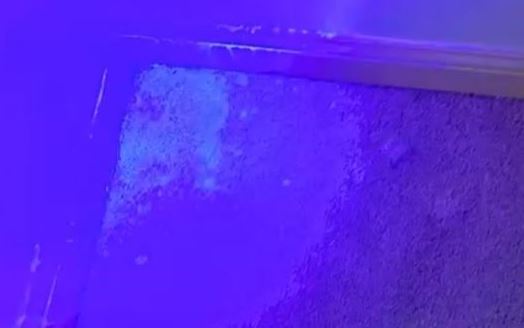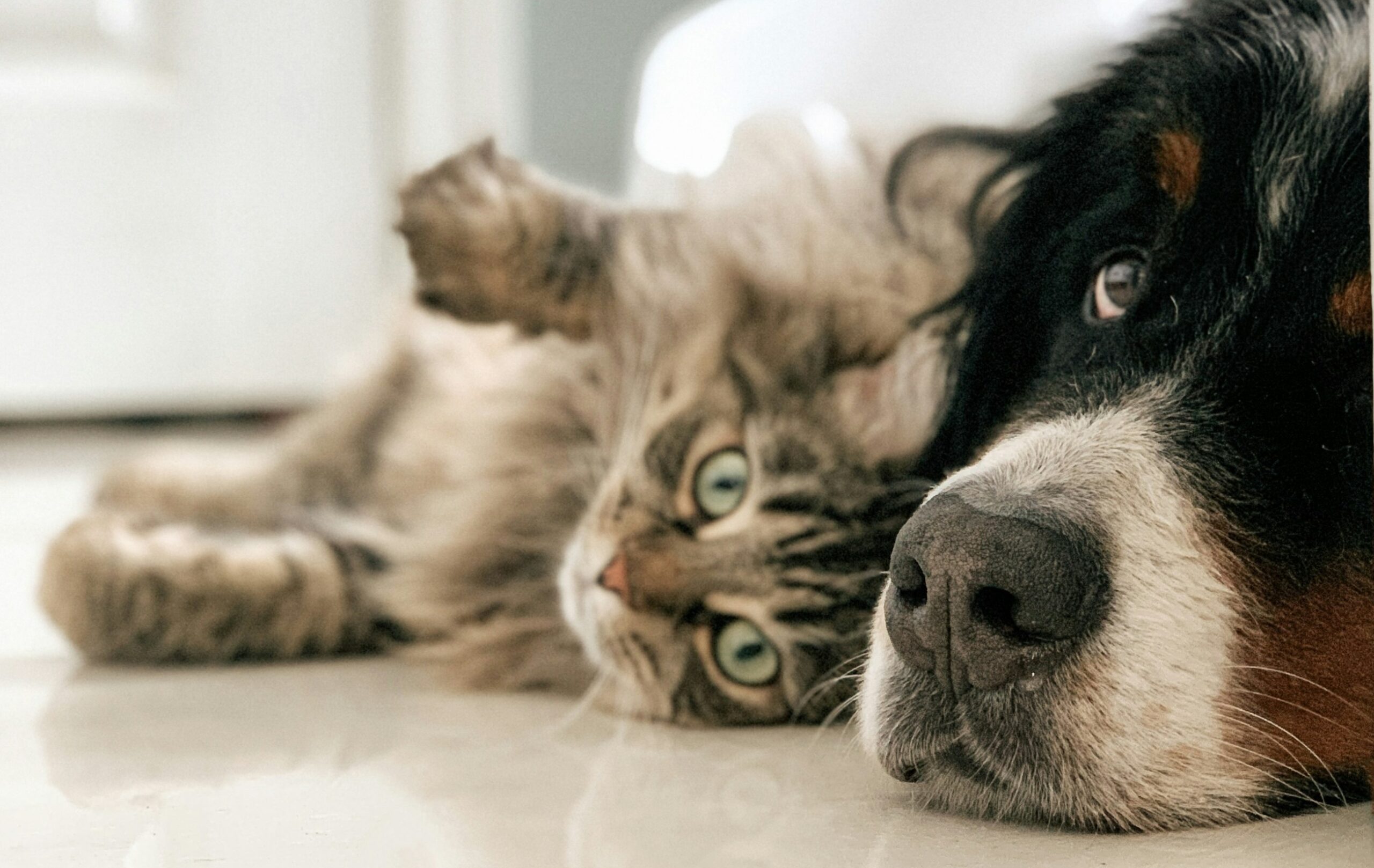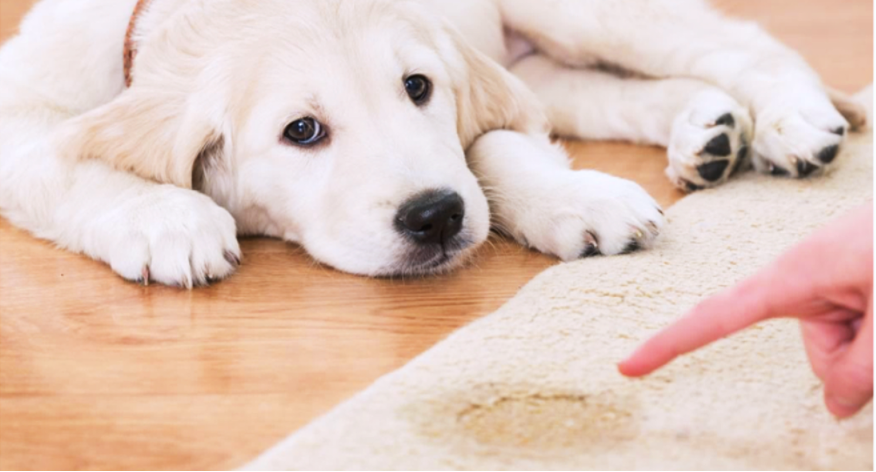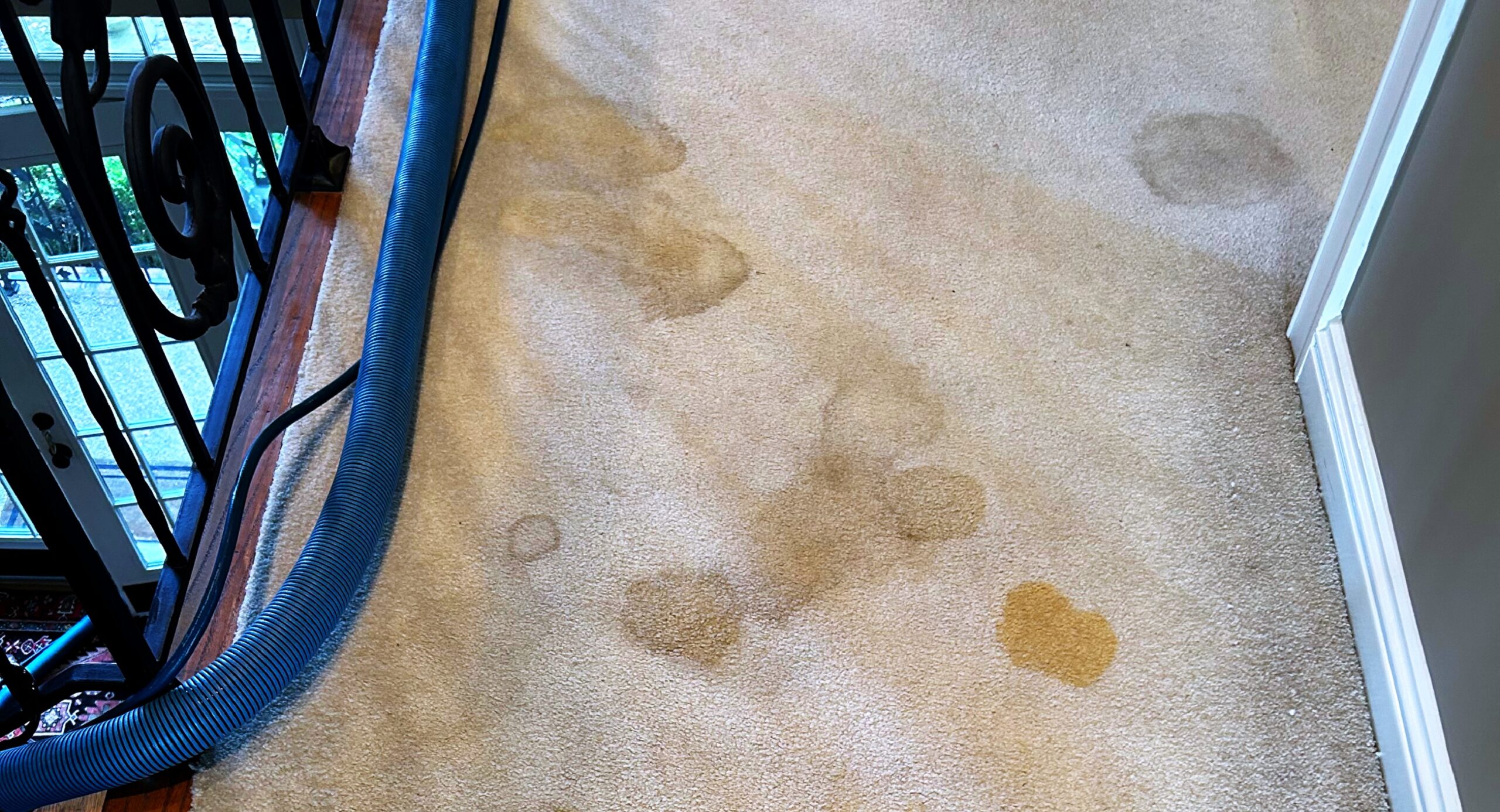Pets Gotta Pee
Pet urine causes more damage to rugs than almost every other substance in the textile world. While we love our four-legged family members, it is hard to ‘absorb’ the thousands of dollars of destruction their accidents can leave behind.
Maybe your fur-child has a health issue or chronic anxiety. Maybe he or she is struggling with house-training. If any of these scenarios sound familiar, it may not be the best time to invest in fine rugs or new carpet. However, if you already have rugs and carpet in your home, read on. This guide will give you the information to understand and respond to pet accidents when they happen.
Why is Pet Urine Damage Such a Hazard?
When it comes to pet pee, timing matters. The moment urine comes into contact with a floor or fabric, it has a pH of about 5 or 6. At this point, the chemical profile is acidic. While some dyes react immediately to that acid, more often than not, a rug or carpet can still be rescued with a quick response.
Fresh pet urine is a breeding ground for bacteria. What’s more, your cat or dog’s pee is chemically impacted by age, health, sex, any medications the pet may be on or any food they eat. What might otherwise be a run-of-the-mill mess can turn into a hazardous cocktail for your flooring. So, the sooner a pet owner can remove the worst of the contamination, the better.
And pet pee is sneaky. What looks like a small spot on the surface of your rug or carpet will spread as it soaks into the fiber. The action of blotting a fresh accident helps to contain that spread and to prevent the urine from seeping down past the backing of your rug or carpet. When it comes to odor, you don’t want that pee to contaminate your carpet pad or, worse still, the subfloor.

Unfortunately, we often miss pet accidents. As a result, their urine can saturate then dry on the fibers of a textile. And stale dog or cat pee is far more dangerous to rugs and carpet than a fresh puddle. Once pet urine begins to oxidize, it can initiate color change in your flooring.
Dried urine’s chemical profile flips180 degrees, turning “alkaline,” with a high pH between 10 to12. At this point it becomes more difficult to remove. If left for days or weeks, depending on the fiber or carpet type, it will change the dye structure, and cause permanent staining.
What Kinds of Damage does Pet Urine Cause?
One of the most obvious impacts dog and cat pee can have on your rug or carpet is that it will ruin the appearance of the textile. Urine contains ammonia which can cause color alteration, color bleed and color loss. Even in the case of a neutral or monotone carpet, the chemistry of pet urine can selectively remove dye colors. This process leaves behind any unaffected dyes and causes serious discoloration.
Equally concerning, pet urine can damage your textile’s fibers. Surfaces like sisal and viscose will darken and harden immediately. Other fiber types will weaken with contact, growing brittle and vulnerable to fraying. What’s more, fibers left in a perpetual state of moisture will begin to delaminate from their backing. This is a structural outcome that cannot be repaired.  Worse still, rugs or carpets subject to urine contamination can make for an unpleasant home environment. The odor from pet urine becomes harder and harder to remove as accidents proliferate. And if a pet can smell that odor, it will mark the same area, over and over again. There is also the likelihood that wet material will grow mildew and other bacteria, becoming a health hazard.
Worse still, rugs or carpets subject to urine contamination can make for an unpleasant home environment. The odor from pet urine becomes harder and harder to remove as accidents proliferate. And if a pet can smell that odor, it will mark the same area, over and over again. There is also the likelihood that wet material will grow mildew and other bacteria, becoming a health hazard.
If the soiled item does not get a deep, effective cleaning, the urine will continue to release a strong odor, every time it becomes wet. That odor, and the respiratory effects that it can cause, has serious implications for a family’s quality of life.
What do You Do When Pet Urine Happens?
Act quickly! Pet urine is easiest to remove when fresh. Use white papertowels to blot up as much of the moisture as possible. Be mindful that fussy surfaces like sisal and viscose react negatively to all liquids, including clear water. If your pet has left urine on a grass or viscose rug, no matter how fast you get to the accident, time may have run out. A professional can help you determine if the item is salvageable.  Blot your carpet or rug until no wetness shows on your papertowels. Next, blend a tiny amount of gentle dish-washing detergent with warm water (approximentally 1/4 tsp detergent to 1 cup of water). This mild cleaning solution is safe for most wall-to-wall carpets. If your carpet is 100% wool, be prepared to tweak that cleaning regimen.
Blot your carpet or rug until no wetness shows on your papertowels. Next, blend a tiny amount of gentle dish-washing detergent with warm water (approximentally 1/4 tsp detergent to 1 cup of water). This mild cleaning solution is safe for most wall-to-wall carpets. If your carpet is 100% wool, be prepared to tweak that cleaning regimen.
In contrast to carpet, rugs vary widely in their recommended care profiles. Synthetic rugs made of polyester, nylon and olefin are generally hardy. Rugs made from natural fibers like wool, silk, or cotton have more specific cleaning needs. If you determine your fiber is synthetic, apply the water-soap solution cautiously. Little by little, dribble the mixture onto the spot. Then blot with fresh towels until you see reduction of the spot area and any yellow coloration.  Professional cleaners will tell you – it is often the efforts a homeowner makes to ‘fix’ a spot or spill that leads to irreversible harm. Do not apply commercial cleaners and do not rub or scrub the area. Once you’ve diluted the spot, your best bet is to call a cleaning company you trust.
Professional cleaners will tell you – it is often the efforts a homeowner makes to ‘fix’ a spot or spill that leads to irreversible harm. Do not apply commercial cleaners and do not rub or scrub the area. Once you’ve diluted the spot, your best bet is to call a cleaning company you trust.
Use these top Six Strategies to Prevent Pet Urine Damage
-
Purchase Wisely
When planning with pets in mind, choose flooring and furniture that can stand up to hard use. Whatever your life circumstances, some carpets and some rugs are a better match to your needs than others are. An informed salesperson can help you make the best investments for your ilfestyle. -
Opt for Fabric Protection
Even some “performance” fabrics can fail to perform when it comes to pet urine damage. An after-market protectant can buy you an extra minute or two to respond to an accident before it leaves lasting damage. Ask your professional service company for a family-safe protection product. Trained technicians will insure that your items get even coverage with a quality, commercial grade product. 
-
Use a quality rug pad…
…Under any area rugs. This is not only good for comfort underfoot and the longevity of your rug. It is also a way to absorb an accident and slow the leakage from the rug onto the floor beneath it. This is especially important if your floor is hardwood. -
Create an Emergency Spot Response Plan
Keep white paper towels and gentle dish detergent like Dawn (no bleach, no lanolin) on the ready. Again, the most important step is to blot up as much urine, as quickly as possible. -
Beware DIY AdVice
There are a lot of well-meaning folks out there, from your second cousin to your favorite Pinterest poster. They all have suggestions of how to clean the surfaces in your home. When it comes to high-end carpet and luxury rugs, it is better to go to professional sources, like the Carpet and Rug Institute or Lisa Wagner’s “Rug Chick” website, for the best advice. -
Schedule regular cleanings…
…For your carpet, rugs and furnishings. You’ll enjoy a healthier home and longer-lasting textiles. Unsure how to find a trustworthy, local pro? Apply these tips to cleaners in your area and choose with confidence.

A Word About Cat Urine
Cat parents claim that cat pee smells stronger than dog pee. Turns out, they’re right. House cats have evolved from wild felines that originated in hot, dry habitats. By reabsorbing the water from their urine, the cat species learned over time to survive extreme dehydration. But the side effect of this adaptation is that your little leopard eliminates darker, more concentrated and pungent urine than its canine siblings.
Hormones and marking behaviors are a further complication of cat urine. To control for these issues, you may need to spay or neuter your indoor feline. And although dogs may pee repeatedly on a rug or carpet, cats are particularly likely to keep marking or spotting the same area of your home, due to the natural habits of the species. This kind of abuse takes pet urine damage to a whole other level.
The sooner you remove set-in urine stains, the more quickly you can curb your cat’s marking behavior.
So, How do You Know if There is Urine Damage in your Home?
Not sure how to detect whether Spot has left a spot (or other biological contaminants) on your furniture, carpet or rugs? Do what the professionals do. Pull down the shades, turn off the lights and power up a black light. You can buy a UV flashlight for less that $20.00. Use that black light to scan the textiles in your home. If there is dog or cat pee there, it will glow greenish-yellow or sometimes, white-blue. .
Pet pee remains, long after the incident. Even if you’ve never had a pet in your home or apartment, old pet urine from previous occupants will still show up. Beware of deodorizing floors with some retail product. That strategy only masks the urine smell. Unfortunately, home sellers looking to invest as little money as possible sometimes use deodorant to hide urine problems.
When you are house-shopping, consider bringing along that black-light. What you discover may go a long way to explaining musty odors and will give you a lot of leverage. If the problem is widespread, you may decide to give the home a pass altogether.
Be warned. Even if a spot has been deeply cleaned, to the point that there is no bacteria and no visible stain by the light of day, your pet will be able to detect any lingering odor. When you bring a dog or cat into a home with old urine contamination, chances are your pet, no matter how well trained, will re-mark the spot to claim its territory.
Pro Tip: When we turn rug or carpet cleaning over to a professional company, we very naturally assume that our home will smell fresher after the job is done. But what if our carpet smells worse after a professional cleaning? It might be that old stains have been re-activated by the introduction of warmth and moisture. Give the carpet time to dry then decide if you want to schedule a second cleaning appointment. If you have a stinky rug, consider sending it to a rug plant where technicians have the most effective urine mitigation strategies and quick-dry technology.
Just Pee Prepared.
Now you have the facts. The key is to start with an understanding of how you want to live in your home, including the needs of your four-legged family members. If you are looking to add new carpet, rugs or furnishings to your home, limit your search to items meant to perform well in households with pets. If you are moving to a pre-owned address, use your blacklight to detect pre-existing urine damage.
Pet spots aside, if there is wall to wall carpet, you will likely want to schedule a professional cleaning before your move-in date. Opting for deep cleaning and protection is a great strategy to care for your current rugs and furnishings. You’ll be starting with a base-line clean. Better yet, you’ll get that grace period you need to go get your ERSK (Emergency Response Spot Kit) (our acronym) (yes, we’re nerds). If you are blotting up the accident on a rug, remember to clean the pad beneath it as well.
When you are dealing with pet urine issues, steer clear of any cleaning advice that doesn’t come from a ‘vetted’ source. A one-off spot is one thing. More chronic issues will call for a lot of effort and the right cleaning products for the job. In the end, there is only so much DIY you can do. If you want a better-smelling, more deeply clean textile, remember, the pros are a great resource.
Pet Pee Happens.
Most importantly, don’t be embarrassed about a carpet or rug that has suffered pet urine damage. Anyone who has a furry friend knows that pet pee happens. When you purchase wisely and prepare thoroughly, you give yourself a fighting chance to keep pet messes under control. If that ship has already sailed and you just need to schedule a professional cleaning, be assured, folks like us have seen it all. We have the training, products and protocols to make pet pee issues a thing of the past.
In fact, professional cleaners have a special name for pet urine damage.
We call it “job security.”
Remove Set-In Urine Stains from Your Carpet with these 5 Steps…



